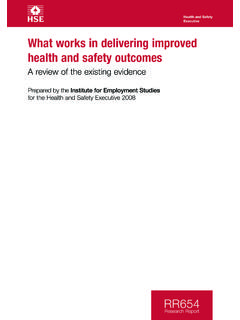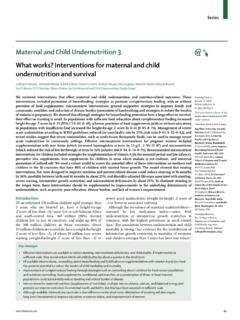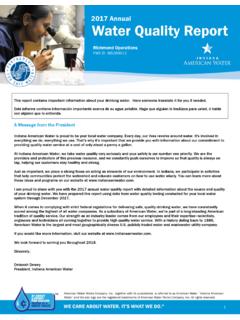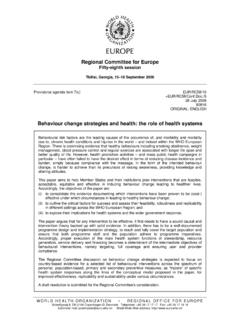Transcription of WHO Public Health & Environment Global Strategy …
1 1 WHO Public Health & Environment Global Strategy Overview 2011 I. Focus on Primary Prevention Environmental hazards influence over 80% of the communicable and noncommunicable diseases and injuries monitored by WHO. Overall, environmental hazards are responsible for about one-fourth of the total burden of disease worldwide. In developing countries, the burden of disease due to environmental hazards is heavily weighted towards communicable diseases. In developed countries, environmental hazards have a bigger impact on noncommunicable diseases. Public Health and Environment (PHE) PHE s role is to promote a healthier Environment by influencing Public policies to address the root causes of environmental threats to Health and intensifying primary prevention.
2 PHE influences policy by producing evidence-based risk assessments, formulating updated norms and guidance on major environmental hazards to Health and creating guidance, tools and initiatives to facilitate healthy policy decision-making in high environmental hazard sectors. PHE's strategic priority is avoiding and eliminating unnecessary illness, injury and death through primary prevention of environmental hazards. PHE's focus is on population-wide, proactive, upstream preventive actions before unhealthy conditions and their costs occur. Such actions include eliminating lead in paint, stopping the use of asbestos, eliminating mercury in medical measuring devices and reducing indoor air pollution.
3 Focusing on primary prevention makes great sense as unhealthy conditions and their associated costs can be avoided. Unfortunately, the best available estimate is that today less than 5% of world-wide spending on Health is allocated to prevention. The good news is that returns on investment in prevention can be extremely high - primary prevention of environmental hazards delivers great value for money with impacts on Health and the economy that go well beyond the immediate reduction in incidence or severity of disease. In the area of climate change for example, good preventive policies needed to meet greenhouse gas emissions targets can significantly and favourably impact heart disease and respiratory illness.
4 A shift to sustainable urban transport could cut heart disease by 10-25%. Improved stoves reducing indoor air pollution could save millions of lives in India alone. 2 In a broader economic and fiscal policy context, rapidly rising Health -care expenditures are not yielding commensurate improvements in Health . From 1997 to 2007, total Health expenditure world-wide as a share of GDP rose at a compound annual rate of On a per capita basis, total expenditure on Health has grown world-wide at or above 6% per year from 2000 to 2008 while gains in life expectancy gains have been below per year. By 2008, 23 countries across the world had Health expenditures of at least 10% of GDP.
5 Continuing at the same growth rate going forward, in ten years time these same 23 countries expenditure on Health would be close to 15% of GDP on average, with real questions as to sustainability. Treatment of chronic conditions is a major factor in rising expenditure on Health . Medicare data from the United States for example, shows 10 chronic conditions accounted for 51% of the growth in spending from 1997 2006. Environmental risk factors are known to contribute significantly (above 10%) in half of these conditions. The rising impact of chronic conditions is an issue in every region of the world, led by Western Pacific and South-East Asia. From both an economic and ethical perspective, focusing on primary prevention of environmental risk factors is good policy.
6 By focusing on reducing environmental risk factors, nearly a quarter of the burden of disease could be prevented, helping ensure the sustainability of Health expenditures. II. Major Areas of Work PHE is focused on developing and advocating effective policies to prevent environmental risks to human Health based on improved scientific understanding. Poolliicciieess ffoorr aa hheeaalltthhyy eennvviirroonnmmeenntt iinnvvoollvvee ccoonnssiiddeerraattiioonnss aaccrroossss aa mmuullttiittuuddee ooff iissssuueess aanndd Some examples: Water, sanitation & hygiene guidelines to inform policy making and prevent waterborne diseases Indoor air policies to substitute fuels & cook stoves Outdoor air policies to minimize the Health impact of urban transport Housing standards and policies to reduce exposure to radon, lead, asbestos and other harmful chemicals Chemical regulation policies to restrict or stop the use of highly hazardous chemicals in industry, agriculture and in consumer products and promote the use of safer alternatives Many of the environmental risk factors PHE works on are increasing in importance.
7 Continued increases in urbanization are driving greater exposure to/increasing the intensity of air quality, water, and waste-related risks. Rising employment in the informal sector is exposing more and more people to occupational hazards. Continued growth of the chemicals industry (especially in lower- and middle-income countries) without a corresponding development of policies and infrastructure for safe chemicals management is increasing the risk of chemical exposure and ill- Health . At the same time, a better understanding of chemicals risks is 3 expanding the scope for safe chemicals management policies and infrastructure.
8 Rising oil prices and efforts to improve energy efficiency have potentially perverse effects higher exposure to radon gas in energy-efficient homes, and to increased particulates from a switch to diesel engines. Sustained dependence on fossil fuels, coupled with social unrest in oil-producing countries, has resulted in greater engagement in more technologically challenging and more environmentally sensitive resource extraction activities ( oil sands in Canada, deeper off-shore oil drilling in Brazil). Finally, climate change is exacerbating a whole range of risks. PHE provides assistance and guidance in responding to environmental emergencies around the world.
9 In 2010 alone, PHE was involved in chemical mud spills in Hungary, heavy metal poisoning in Nigeria, mitigating Health effects of wildfires in Russia and in helping to address water & sanitation crises following the earthquake in Haiti. At the heart of PHE's work is assessing environmental and occupational risks and defining Health and safety standards to reduce exposure; working broadly across regulatory and legislative processes to promote policies delivering Health co-benefits and avoidance of Health risks; and where appropriate, focusing efforts on specific settings such as extractive industries or vulnerable population groups such as children to better address particular areas of elevated risk.
10 PHE's ability to have an impact depends on maintaining a balance of strong scientific and policy capabilities as well as emergency response capacity across a number of technical areas such as Water, Sanitation and Hygiene, Chemicals Management, Radiation Protection, Occupational Health , Climate & Environmental Science, and Air Quality. Water, Sanitation and Hygiene: PHE's focus is on reducing water- and waste-related disease and optimizing the Health benefits of sustainable water and waste management. PHE has long history of successful Global leadership in this area and has played a key role in setting water-quality standards. In the area of Water, Sanitation and Hygiene, in addition to focusing on millennium development goals (MDGs), the major areas of work include.














